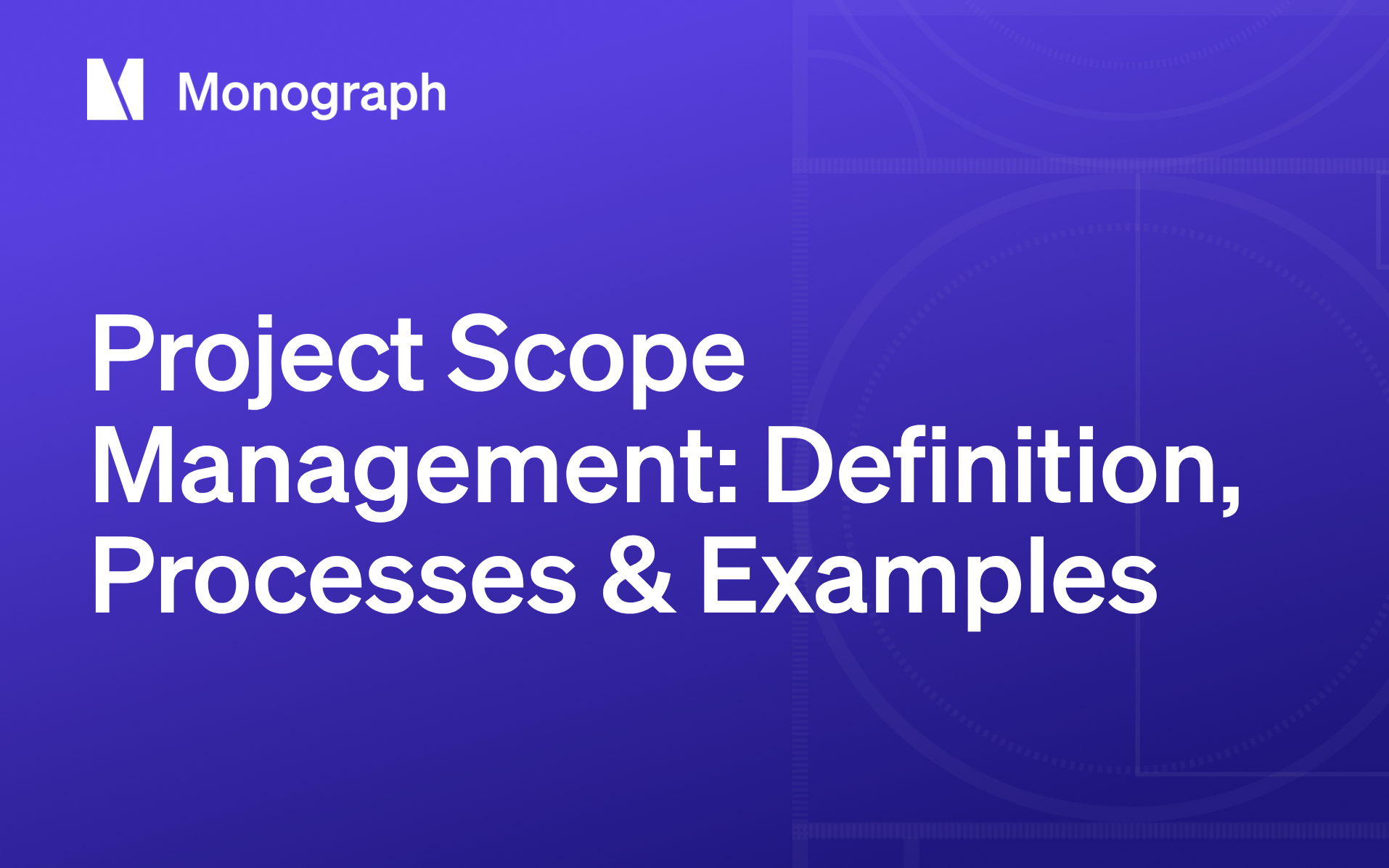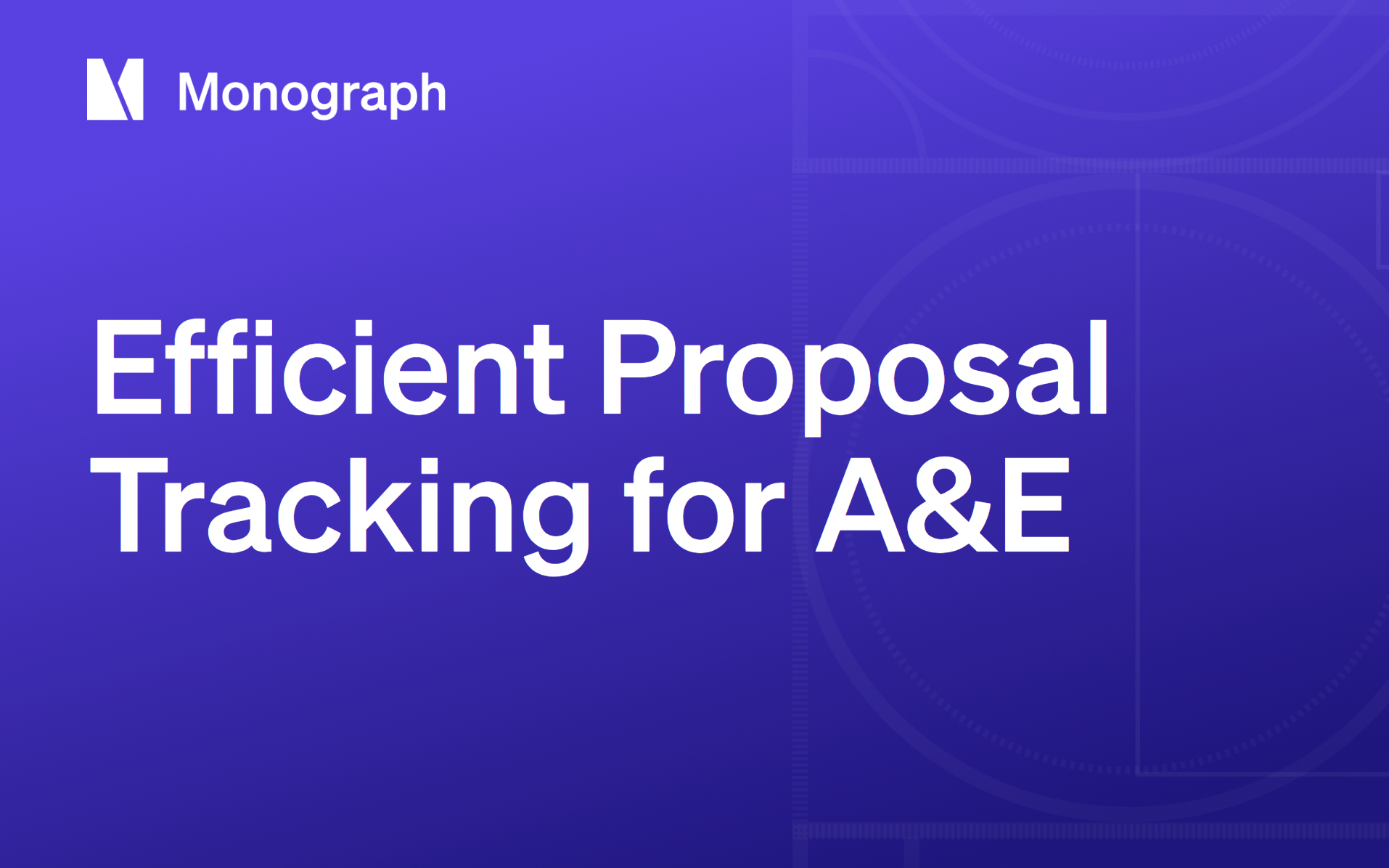Contents
Firms that switch their project tracking from spreadsheets to Monograph add an average of 21 percent more revenue in the first year: proof that controlling project scope isn't just good practice, it's profitable. Yet many A&E teams still wing their scoping process, and the results are predictable: scope creep drives budget overruns, missed deadlines, and those uncomfortable client conversations where everyone asks "how did we get here?"
I've watched this spiral destroy otherwise good projects. When a quarter of your active work is on hold while you sort out unclear deliverables, your forecasting falls apart and cash flow follows. This chaos isn't inevitable: it happens when firms skip the foundational steps that keep projects on track.
What follows is a six-step framework that works for both architects and engineers. We'll move from initial planning through ongoing control, using examples you'll recognize from your own projects. By the end, you'll have a system that keeps every project on scope, on schedule, and profitable, turning that 21 percent revenue increase from a lucky break into standard practice.
Quick Definition and Why It Matters
When I talk about scope on a project, I'm not thinking in abstract PM lingo: I'm thinking about the concrete list of drawings, calculations, and permits you've promised a client. Project scope management is the discipline of defining, documenting, and controlling that list so the work stays exactly where you want it, no more, no less. It's the guardrail that keeps projects from drifting off course, whether you're detailing a curtain wall or modeling a storm-water system.
Without tight scope control, every "quick change" turns into scope creep, budget overruns, and misaligned stakeholder expectations. Architecture and engineering firms feel this pain more than most: our work unfolds in multi-phase, consultant-heavy cycles where even a small shift in one discipline cascades across the entire team.
Monograph exists to replace the spreadsheet chaos and disconnected tools that make those shifts hard to see until it's too late. Firms running their projects in Monograph add 21% more revenue on average in their first year because they spot variance in real time instead of at the end of the phase. The six-step framework that follows turns that visibility into a repeatable process, so you keep projects profitable and clients happy, one clearly defined scope at a time.
Project Scope Management Processes at a Glance
Every profitable A&E project follows the same six processes. Here's how each step creates a systematic approach to boundary management that replaces the uncertainty of spreadsheet-based tracking:
Each process serves a specific purpose in maintaining project boundaries:
- Plan Scope Management: Create a written playbook that spells out how scope gets defined, approved, and controlled instead of winging it project by project.
- Collect Requirements: Document every business, stakeholder, functional, and technical need upfront so nobody can claim "I thought this was included" later.
- Define Scope: Turn raw requirements into a bulletproof scope statement with clear deliverables, exclusions, constraints, and assumptions.
- Create WBS: Break the agreed scope into manageable work packages you can actually schedule, budget, and assign with confidence.
- Validate Scope: Get formal sign-off on completed deliverables at each milestone, not just at final handover when problems cost the most to fix.
- Control Scope: Monitor work against the baseline and route every change through structured approval to prevent scope creep from killing profits.
These aren't linear steps you complete once. You'll cycle through planning, validating, and controlling throughout every project. The firms that master this cycle consistently deliver projects on scope, on schedule, and on budget.
Step 1: Plan Scope Management
Before anyone sketches a line or runs a calculation, you need a written roadmap that spells out how project boundaries will be defined, approved, and controlled. This document: the Scope Management Plan, anchors every subsequent decision. It covers three essentials: how you'll define scope, who owns which responsibilities, and the protocol for vetting change requests. Skipping these basics is like starting a foundation without surveying the site.
A solid plan opens with a clear statement of objectives and deliverables, then lists boundaries, constraints, and assumptions drawn from early discovery sessions. Stakeholder involvement in planning is critical. That's why the kickoff meeting for a mixed-use development always brings the architect, MEP, and structural consultants to the same table. Together, you outline phase gates: concept design, DD, CDs, CA, and agree on how late-breaking tenant requests will funnel through change control.
Engineers face the same reality. On a highway-widening project, the civil team maps out every permitting milestone: environmental review, utility relocation, right-of-way acquisition, and pins responsibility to named people. When the city adds a noise-barrier study mid-stream, the change-control protocol already baked into the plan decides whether it's in scope or a billable extra.
Store the plan where everyone can see it. Monograph keeps the latest version and every revision one click away, eliminating "I never saw that" debates. Get this step right and the project moves forward with fewer assumptions, faster approvals, and a shared understanding that protects both design intent and profit.
Step 2: Collect Requirements
You need absolute clarity on what "done" looks like before any design work begins. The Collect Requirements process turns vague client wishes and technical constraints into a single source of truth your entire team can build from. Structured interviews, surveys, and workshops surface hidden needs quickly, while a field-tested checklist prevents you from overlooking critical regulations or site conditions.
You'll rely on four data-gathering staples: stakeholder interviews, RFIs, code analysis, and existing-conditions surveys. For a school renovation, start by sitting with the facilities director to capture sustainability goals like a LEED Silver target and 30% energy savings. Every note goes straight into Monograph so the client can review and sign off the same afternoon: no version confusion, no email scavenger hunts.
Engineering projects demand the same rigor. When you size girders for a municipal bridge, loading criteria from city design guidelines, floodplain ordinances, and AASHTO specs all qualify as requirements. Document them once, tag them "Structural Technical," and you'll never wonder which live-load factor the team agreed to.
Categorize each requirement systematically:
- Business (budget cap, ROI targets)
- Stakeholder (user comfort, public safety)
- Functional (workflow adjacencies, span length)
- Technical (seismic rating, material specs)
A simple requirements traceability matrix links every item to a design task, budget line, and eventual deliverable. When a requirement changes, you see the ripple effect instantly and can issue a change order before hours evaporate. Get this step right and you'll head into the next phase with a blueprint that reflects reality, not assumptions, and a client who feels heard.
Step 3: Define Scope
With requirements in hand, you're ready to lock the project boundaries by drafting the Project Scope Statement: the single document that tells everyone what work counts and what doesn't. Think of it as the contract set for your management process: if it's not documented here, it's not your responsibility. You need to spell out objectives, deliverables, exclusions, constraints, and assumptions, then circulate the draft for sign-off before a single hour hits the budget.
I keep the structure tight:
Objective: _____________________________________
Deliverables: __________________________________
Exclusions: ____________________________________
Constraints: ___________________________________
Assumptions: ___________________________________
Approval Signatures: ___________________________Notice "Exclusions." They're your first defense against boundary drift: explicit statements of work you will not perform. For an architecture project, I might write: "Services conclude at construction administration; FF&E selection is excluded." On the engineering side: "Analysis limited to geotechnical soil evaluation; remediation design excluded." Clear language like this prevents the late-night email that starts with, "We thought that was included."
After content is agreed, lock the baseline. Version control matters as much as the words themselves; watching a client reference "v2" while your team designs from "v1" creates expensive rework. Storing the document in Monograph gives you firm-wide visibility: no more hunting through email chains for the latest PDF.
Secure stakeholder signatures. A signed statement turns ambiguous expectations into an enforceable agreement that survives staff turnover, code changes, and litigation. When disagreements arise, you can point to the approved document and say, "This is what we promised and delivered."
Step 4: Create the Work Breakdown Structure (WBS)
When a project lives only in your head, or worse, in a single spreadsheet, tasks disappear, budgets drift, and deadlines sneak up. A Work Breakdown Structure fixes that problem. Think of the WBS as your project's blueprint: it breaks down your entire agreement into manageable chunks that you can actually track and cost out.
Every piece in a WBS has a clear owner, duration, and budget. Once you build this foundation, your scheduling tool stops guessing and starts working from the same playbook as your budget and your team.
Take a mixed-use building. Break the work into Schematic Design, Design Development, Construction Documents, and Construction Administration, then go one level deeper. Under Design Development, you might have "façade studies, MEP coordination, code analysis." Each task gets estimated hours and a fee, so you catch overruns before they snowball.
Engineers follow the same logic. A highway widening starts with Site Survey, Load Calculations, 3D Modeling, and Field Testing. Drill down further: "Field Testing: soil borings, asphalt cores, traffic control," and suddenly responsibilities are crystal clear.
In Monograph, these work packages feed directly into Monograph's MoneyGantt™. Hours logged by your team instantly update the visual, so you spot boundary drift before it eats your profit. No more hunting through three different systems to figure out where you stand.
Monograph's Project Planner helps you define each phase with clear objectives, timeline, and resource assignments. You can break work into manageable components, assign team members to specific roles, and track progress against budgets in real time. The platform makes it easy for any team member to understand their responsibilities while giving project managers the oversight they need without micromanaging.
Step 5: Validate Scope
Validation is your formal handshake with stakeholders. Instead of waiting for the grand reveal at project close-out, you secure acceptance at each milestone: schematic design, 100% design development, final hydraulic model, and so on. The process is simple: you confirm that the deliverable matches the signed agreement, capture approval in writing, then move on. Without stakeholder acceptance, you're building on shaky ground.
How you collect that sign-off depends on the moment. A quick inspection in the field, an owner walk-through in a VR model, a stamped sign-off form filed in your document management system: each counts. What matters is that the right person says "approved" and the decision is traceable.
Take a mid-rise school renovation. At the 100% DD checkpoint, the owner's rep reviews the drawing set against the sustainability objectives captured earlier. When the package hits every criterion: daylighting analysis, low-VOC specs, energy model target, the rep signs the acceptance form. That signature freezes boundaries for the next phase and keeps late-stage "could we also..." requests from derailing fee and schedule.
On the engineering side, picture a hydraulic model for a storm-water upgrade. The city engineer compares the model output to municipal flow thresholds, checks the assumptions log, and issues a compliance letter. That letter is your ticket to start detailed design; without it, you'd risk redesign after thousands of billable hours.
Monograph makes these moments stick. Every approval, whether a PDF sign-off or an in-app comment, gets a timestamp and ties to the relevant phase, creating an audit trail your attorney would admire. Quality control asks, "Does this calculation hold up?" Validation asks, "Is this the calculation we promised to deliver?" Keep the two distinct, and you avoid the Friday-afternoon surprise of a rejected package. By validating early and often, you replace last-minute firefighting with steady progress and predictable cash flow.
Step 6: Control Scope
By the time drawings are flying back and forth, you're juggling RFIs, submittals, and field surprises. Control is the safety net that keeps those moving parts from crashing your budget. PMI calls this the discipline of "ongoing monitoring": you're comparing the work being done to the work you actually agreed to do and correcting course before overruns stick.
The essentials come down to three habits:
- Change-request workflow: Every new idea, adding a green roof, swapping materials, updating codes, enters a formal queue. You log the request, assess cost and schedule impact, route it to decision-makers, and only then give the team a green light.
- Budget-to-actual tracking: Instead of waiting for month-end surprises, watch hours and dollars in real time.
- Communication cadence: Weekly check-ins and visible dashboards keep everyone honest and aligned.
Take an architecture project where the client suddenly wants a roof deck. With a solid control process, you draft a change order, attach the additional fee, and critically, freeze all design work until the client signs. No signature, no boundary expansion.
On the engineering side, imagine a seismic code update released mid-design. You log a change request, quantify extra analysis hours, and secure municipal approval before revising calculations. The project stays on track because the change is documented, budgeted, and shared with every discipline lead.
Monograph makes this control straightforward. Dashboards alert you the moment a phase burns hotter than budgeted, and firms report a 44% drop in over-budget work after switching from spreadsheets. Monograph's MoneyGantt™ links each change order to fresh hours and fees, so you never lose visibility.
Document even the "tiny" tweaks. A single undocumented site visit can snowball into thousands of unbilled dollars. When every adjustment lives in one system: request, approval, dollars, hours, you turn control from reactive firefighting into routine maintenance that protects profit on every A&E project.
Tools and Templates for A&E Firms
You don't need a cabinet full of binders to keep boundaries on track: you need five essential documents that everyone can access instantly:
- Management Plan outlining how work will be defined, approved, and changed
- Requirements Log that traces every client, code, and technical need back to a deliverable
- Statement template spelling out objectives, deliverables, exclusions, constraints, and assumptions
- WBS Dictionary defining each work package so no task slips through the cracks
- Change-Request Form capturing who asked, why it matters, and what it will cost before work begins
When you manage these documents in Monograph, they stop acting like static PDFs and start driving the project. Logged hours flow straight into budgets, Monograph's MoneyGantt™ updates burn rates as tasks progress, and invoicing pulls from the same data: no copying between systems, no double entry. That single source of truth eliminates the spreadsheet chaos that causes missed approvals and unbilled extras.
Just as important, a clear paper trail protects you when projects get contentious. Every requirement, decision, and change order is time-stamped and searchable, giving you the evidence you need to avoid fee write-offs or legal disputes.
Master Project Boundaries for Predictable Profit
The six-step framework: Plan, Collect, Define, Build the WBS, Validate, Control, keeps every project anchored to the work you actually agreed to deliver. Think of it as a cycle, not a checklist. Once you complete one pass, new information sends you right back to planning.
Guard boundaries this tightly, and three things happen. First, profit stabilizes because unapproved extras get flagged before they eat up hours. Second, clients stay aligned; clear statements and milestone sign-offs leave little room for "I thought that was included." Third, your team gains focus. Engineers know which calculations matter, architects know which drawings are required, and everyone stops chasing phantom tasks born from misaligned expectations.
Each step serves a purpose: planning sets the ground rules, requirements gathering defines what success looks like, definition locks the baseline, the WBS translates vision into actionable work, validation secures client acceptance early, and control protects your budget when changes inevitably arrive.
See How Leading A&E Firms Master Project Boundaries
While you're manually updating project budgets and tracking scope changes across multiple spreadsheets, firms like Dynamic Engineering and BRNS Design are using integrated project management to automatically track scope, predict overruns, and streamline workflows.
They're winning more profitable projects and growing margins through systematic scope control.
Ready to transform your project boundaries? Book a demo with Monograph and see how the right tools turn scope management from reactive firefighting into predictable profit.
Frequently Asked Questions
What's the biggest scope management mistake A&E firms make?
Skipping the exclusions section in their scope statements. Without explicitly stating what work you won't perform, every client request becomes a negotiation about whether it was "obviously included." Clear exclusions prevent scope creep before it starts and give you firm ground to stand on when issuing change orders.
How detailed should a Work Breakdown Structure be for architectural projects?
Detailed enough that any team member can pick up a work package and know exactly what deliverables are expected, but not so granular that you're micromanaging every hour. A good rule: if a work package takes longer than two weeks to complete, break it down further. If it takes less than a day, combine it with related tasks.
Can small firms implement scope management without dedicated project managers?
Absolutely. The framework scales to any firm size. Small firms often have principals wearing multiple hats, but the same six-step process applies whether you're managing two projects or twenty. The key is choosing tools like Monograph that automate the administrative work so you can focus on design and client relationships instead of hunting through spreadsheets for budget updates.





